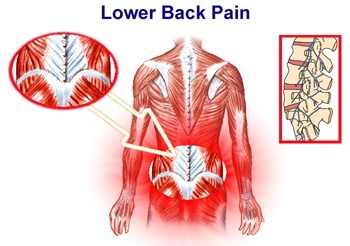Sports Injuries
Lower Back Strain
Lower back pain is a fact of life. Just about everybody will suffer from it sooner or later. One of the main causes of back pain, whether acute or chronic, is low back strain.
So what is low back strain?
A series of muscles and ligaments in your back hold the bones of your spinal column in place. You can strain these muscles by stretching them too far, causing tiny tears in the tissue. The muscles are then weakened, so they may not be able to hold the bones of your spinal column in place correctly. The spine becomes less stable, causing low back pain.
And because nerves stretch out from the spinal cord throughout the entire body, low back strain can cause pain in areas other than your back.
Low back strain can be caused by:
•Extreme physical exertion.
•Falling.
•Bending or crouching repeatedly.
•Lifting heavy objects if you are not in shape.
It can also be caused by emotional stress, improper posture, being overweight, out of shape, or sitting in the same position for long periods of time. Even a severe cough can result in low back strain.
Keep in mind that low back strain can’t be blamed for all back pain. There are many other causes, like slipped discs, fractures, pinched nerves, arthritis, infections, and tumors.
What Does Low Back Strain Feel Like?
Symptoms of low back strain include:
•Pain and stiffness in the back.
•Pain in the buttocks and the legs, often in the back of the thigh.
•Pain that worsens when bending, stretching, coughing, or sneezing.
Since some symptoms of low back strain are similar to those of more serious conditions, it’s important to get checked out by a doctor. Any numbness and weakness in your legs, or bowel and bladder problems, can be a sign of nerve damage — and that needs immediate medical attention.
To diagnose low back strain, your doctor will give you a thorough exam. You may also need X-rays, MRIs (Magnetic Resonance Imaging), and CT scans. These extra tests may only be needed if your pain doesn’t go away on its own or with conservative treatment.
What’s the Treatment for Low Back Strain?
Low back strain can be a painful and depressing injury. But the good news is that most cases heal on their own, given time. To speed the healing, you should:
• Ice your back to reduce pain and swelling as soon as you injure yourself. Do it for 20-30 minutes every 3-4 hours for 2-3 days. You can also ice your back after physical activity.
• Apply heat to your back — but only after 2-3 days of icing it first. Use heat on your back only after the initial swelling has gone down. You could use an electric heating pad or a hot water bottle. Or you could just soak in a hot bath.
• Take painkillers or other drugs, if recommended by your doctor. Non-steroidal anti-inflammatory drugs (NSAIDs), like Advil, Aleve, or Motrin, will help with lower back pain and swelling. However, these drugs may have side effects. They should be used only occasionally, unless your doctor specifically says otherwise. Prescription painkillers and muscle relaxants are sometimes necessary.
• Use support. Ask your doctor or therapist first, but consider getting a belt or girdle to add support to your back. Use it only short-term or for support with heavy or repetitive lifting.
• Get physical therapy to build up strength, if your doctor recommends it. Do not stay in bed or on the couch all day. That will make it worse.
• Maintain good muscle tone in your abdominal and lower back muscles.
No matter what people tell you, bed rest doesn’t work. People used to think that the best treatment for low back strain was to lie on your back until you felt better. But studies show it doesn’t help. In fact, after taking it easy for a day or two, you should usually start light physical activity.
When Will My Lower Back Strain Feel Better?
Recovery time depends on how serious your low back strain is. Mild cases may resolve in a couple of days. It can take many weeks for more serious strains. Remember that everyone heals at a different rate.
Once the back pain is gone, your doctor will probably want you to start a regular exercise routine. This will get your back muscles stronger and more limber. It will help you recover, and reduce your odds of low back strain in the future. Your doctor will probably want you to take up low impact sports, like swimming or using a stationary bike.
Whatever you do, don’t rush things. Don’t try to return to your previous level of physical activity until:
•You can move as easily — without stiffness — as you did before your injury.
•You feel no pain when you bend, twist, walk, run, and jump.
If you start pushing yourself before your low back strain is healed, you could end up with chronic back pain and permanent injury.
How Can I Prevent Low Back Strain?
Here are some tips to help you avoid low back strain:
•If you feel any low back pain during physical activity, stop.
•If you feel low back pain within a day of stepping up your workout, take it easy for a few days.
•Get your back in shape. Exercise and stretch your back muscles regularly.
•Avoid sleeping on your stomach. Sleep on your back or your side, and wedge a pillow under or beneath your legs.
•When picking up something heavy, bend at the knees, not at the waist.
•Lose weight if you are overweight.
•Adopt good posture. Sit straight in chairs, with your back against the chair’s back.

